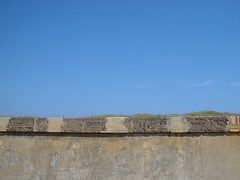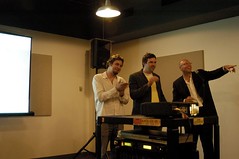What is a PhD? • A PhD thesis represents a substantial body of work. It should be marked by high quality and substantive results. It should push the frontier of knowledge and mark you as an expert in your area of study.
• Thesis research is partly intended to ensure that the student can later take on independent, long-term research commitments.
• Faculty are judged by the theses of their PhD students
• High quality PhD theses is one of the most important factors contributing to the success of leading universities
• PhD thesis research is a challenge with no simple formula for success.
Typical stages of graduate student life (in chronological order):
• Knowing everything (A little knowledge is a dangerous thing)
• Knowing nothing (I am not worthy)
• Gaining confidence (I can do this!)
• Knowledgeable and confident (Based on real experience)
Here are some things a PhD thesis might do:
• Open up a new area and methodology
• Provide a unifying framework
• Resolve a long-standing question
• Thoroughly explore an area
• Contradict existing knowledge
• Experimentally validate a theory
• Produce an ambitious system
• Provide empirical data—In architectural theory these might be seen as commonalities and anomologies.
In my case I studied a subject where I had wanted to dive deeper into how to push the design build movement forward. I could not approach the study with a bias. There were times when i wanted to give up. When I waited in hallways for professors to show up. When i travelled all the way to England. Then Thomas Muir, my supervisor stepped in with amazing clarity and vision.
Advisors:
• Your advisor does not know everything. Your advisor may not always be right. My first advisor retired and I had to start over!
• If at all possible, keep a good and open relationship with your advisor. Your advisor usually has lots of influence even after you graduate. He or she should be genuinely interested in your well-being, and may even be a mentor for your entire career. Mostly likely, your advisor will be writing letters of recommendation for you
Suggestions:
• Consider your fellow graduate students as a very valuable resource ask them questions, see how they do things, tell them your ideas, brainstorm with them, learn from them!
Stages of PhD thesis research
• Selection of the area
• Selection of the advisor
• Becoming a researcher in the area
then….
_ Building up general knowledge and experience
_ Learning the important issues and questions in the field
_ Learning the cutting edge work in some areas
_ Some useful things to do:
_ Read recent proceedings of the best conferences, and ask more senior people what were the best papers. Try to figure out what makes a great paper (and thus what makes great research).
_ Keep a notebook that contains your research notes. Put all of your empirical data and initial ideas in the notebook. Make notes on a paper as you read it and think about the assumptions of the author and the importance of the results.
_ Follow references from one paper to another until you know an area extremely well. Don't count on your advisor to hand you all of the relevant papers out of his file drawer. He/she doesn't have them all!
_ Build a mental model of what has been done in your area. Look for holes interesting areas that have not received much attention.
• Thesis proposal
_ Most crucial stage, since everything flow from here. Later problems can often be traced back to a weak thesis proposal.
_ This is where you need your advisor the most
_ Main challenge: come up with an approach and/or an experiment.
_ Dont just go with your advisors opinions or recommendations (unless you truly believe them). This is the best time to argue with your advisor!
_ Research plan Overview of the expected course of research. Must be flexible, but not vague.
_ Need to elaborate on the focus, the approach, experiments or systems to build, potential impact
_ Forming a committee Choose people who can help with needed expertise if possible, especially if you have an interdisciplinary topic.
_ Thesis proposal questions:
_ What is your approach and what is new?
_ How do you measure your own progress?
_ What are the success or completion criteria?
_ How will the expected results change the-state-of-the-art?
_ Hints:
_ Be honest dont exaggerate your claims, be open with the weaknesses (better for you to raise them than for someone else)
_ Pick a problem/project of manageable size. It is much better to do an excellent job on a moderately sized project than a moderate job on a large project.
_ Prepare a tentative month by month schedule, with milestones, for your work. Be realistic. And flexible, but not vague.
• Producing results
_ Keep your advisor and committee informed. Dont wait until you have a breakthrough result, keep them informed regularly.
_ Talk about major choices with your advisor before youre completely committed to them.
• Knowing when to stop
_ How much is enough? Your thesis does not have to solve every possible related problem. Talk with your advisor about what a reasonable stopping point might be. Re-visit the issue occasionally.
_ If the principles and boundaries of your thesis work were clearly defined from the beginning, this should not be a problem.
• Writing
_ Writing is very time consuming. Really.
_ Remember, few (if any) readers will have your background. Dont assume they know everything you do.
_ Write the introduction last (or at least re-write it last).
• Comments from the committee
_ Committee members are very busy people. _ You want to give them an optimal version for them to comment on some time before the final version not too preliminary, not too finished.
• Defense
_ This should mostly be a formality, at least from the advisors point of view. That is, he or she shouldnt let you get to this point if youre not really ready. There should be no surprises for the committee.
_ However, its still important:
_ The defense gives you a chance to get feedback for final improvements to the thesis.
_ Many people (the committee and the audience) may form their opinions of you and your work from this one event
_ Presentation material can be used for future presentations (job talks, etc.)
_ You should know firmly what the main ideas are, and present them clearly.
_ Set the defense date well in advance it can be difficult to get the committee together.
• Afterwards
_ Usually there is some work to be done (often minor) requested by the committee
_ Publications: conferences, journals, book
_ Are you the sole author of these publications, or is your advisor a co-author (even though you wrote it)?
_ No single answer, but typically the advisor has been very involved and deserves credit of authorship. Ideally, he or she will also help with writing (and re-writing, and proofreading) the subsequent papers.
_ Follow-on work
Are there more ideas or paths to take on this problem? You are now the expert, so why not keep working on it? Starting over on something completely different is not so easy, especially if you are going to be looking for research funding.
Thanks to Professor Mark Turk for his help preparing these notes.


